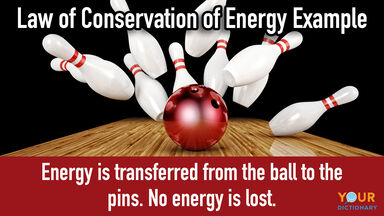Which Statement Best Describes the Law of Conservation of Energy
Water falls from the sky converting potential energy to kinetic energy. The law of conservation of energy states that energy can neither be created nor be destroyed.

Law Of Conservation Of Energy Examples
In physics and chemistry the law of conservation of energy states that the total energy of an isolated system remains constant.

. All the forms of energy follow the law of conservation of energy. Which statement best describes how photosynthesis follows the law of conservation of energy. Which statement below is true.
It is transformed and transferred. The total amount of energy is conserved. When an energy transformation happens no energy is destroyedor createdD.
It only changes form. It is said to be conserved over time. A finite amount of carbon exists on Earth and it moves through living and nonliving materials through the carbon cycle.
Maria analyzed the different types of energy transfers and transformations involved in powering a. In the powering of the train. Energy can be created but not destroyed.
O All systems can exchange energy but not matter with their surroundings. Energy transforms from one form to another form and potential energy kinetic energy constant. Matter cannot be created or destroyed in a chemical reaction B.
The total energy in an open system can only decrease. Consider this energy transformation diagram. Which statement describes the law of conservation of energy.
O All systems will exchange matter and energy with their surroundings. Because energy is conserved. Which of the statements below best describes how the Law of Conservation of Energy plays a role.
In brief the law of conservation of energy states that. Rather it can only be transformed or transferred from one form to another. The total amount of energy is less after a reaction.
Energy cannot change forms in closed systems. If you take all forms of energy into account the total energy of an isolated system always remains constant. Reactants in a chemical reaction rearrange to form a new substance or substances C.
Hence in a system energy might change forms but the total energy on Earth remains the same. The law of conservation of energy states that energy can neither be created nor destroyed - only converted from one form of. The law of conservation of energy is the preserved form of energy.
Light energy from the Sun is converted into chemical energy in plant cells. Law of conservation of energy states that Energy can neither be created nor be destroyed. Of 10 Which statement best describes the law of conservation of energy.
Energy can be destroyed but not created. O Energy cannot be created nor destroyed but it changes from one form to another. The total energy in a system can only increaseSUBNE.
The law of conservation of energy states that energy can neither be created nor destroyed only converted from one. Which option describes the law of conservation of energy. Option 1 is correct that is the total amount of energy in the universe remains constant.
Energy is neither created nor destroyed. This law means that energy can neither be created nor destroyed. O Energy is destroyed in most chemical reactions.
Water can produce electricity. Proof At point A. The law of conservation of energy can be seen in these everyday examples of energy transference.
The correct option is B. Energy can be destroyed only in open systems. Energy cannot be created or destroyed.
What is the difference between a scientific theory and a scientific law. The cue ball loses energy because the energy it had has been transferred to the 8 ball so the cue ball slows down. 1 point There is a limited amount of energy and it remains in the same form.
Assume that the energy input in this case is chemical potential. According to the Law of Conservation of energy the amount of energy before and after a reaction must be the same. Which of the following statements best describes how the uncertainty principle affects conservation of energy.
Correct answer to the question Question 1 of 10 Which statement best describes the law of conservation of energy. You might be interested. A The uncertainty principle invalidated the law of conservation of energy and as a result this law is no longer useful to physicists.
Which of the following statements is most accurate. Which statement best describes the law of conservation of mass. Train using coal as fuel as shown in the diagram above.
B The uncertainty principle tells us that the law of conservation of energy applies only to very large. Select the statement that. Select the TWO answers that are correct.
Which statement best summarizes the law of conservation of energy. The law of conservation of energy states that energy can neither be created nor be destroyed. Which statement best describes the law of conservation of energy.
Does anyone have the answers for Calculating mass quick check. Select the statements that best describe how nucleotides pair with one another in a DNA molecule. Energy can change forms but cannot be created or destroyed.
We know that the law of conservation of energy states that energy can not be created or destroyed. New energy is created and as it is used it is destroyed. The total amount of energy is more after a reaction.
However energy can change from one form to another. Although it may be transformed from one form to another.

Engenharia Ou Arte Parte 2 O Professor Que Transforma Calculos Em Obras De Arte Learn Physics Physics Lessons Physics Teacher

Comments
Post a Comment